Behind the Lens – Andrew Bazeley
by Alex W.
Behind the Lens is an ongoing series of articles and interviews exploring the thought process behind successful and excellent photographers. It brings you behind the lens of a particularly excellent image and explains the technical and creative elements that went into creating the photograph.
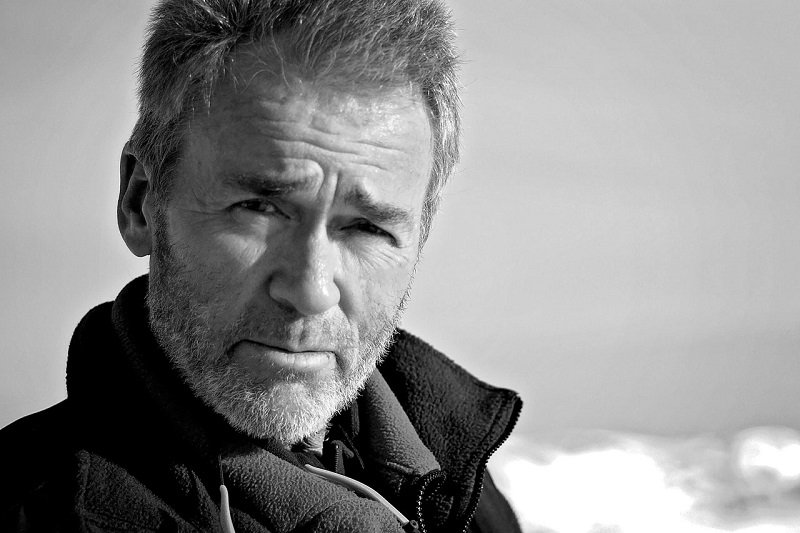
This week on Behind the Lens we meet Andrew Bazeley – A wildlife photographer who was drawn to the genre due to the potential imminent threat of extinction of polar bears. Andrew’s main body of work revolves around one of the most dangerous predators on the planet, but his work has taken him to Alaska, the Amazon, and Africa as well. He is co-author to the polar bear-centric book “Waiting for Dancer” and spends much of his time photographing the apex predators of the world.
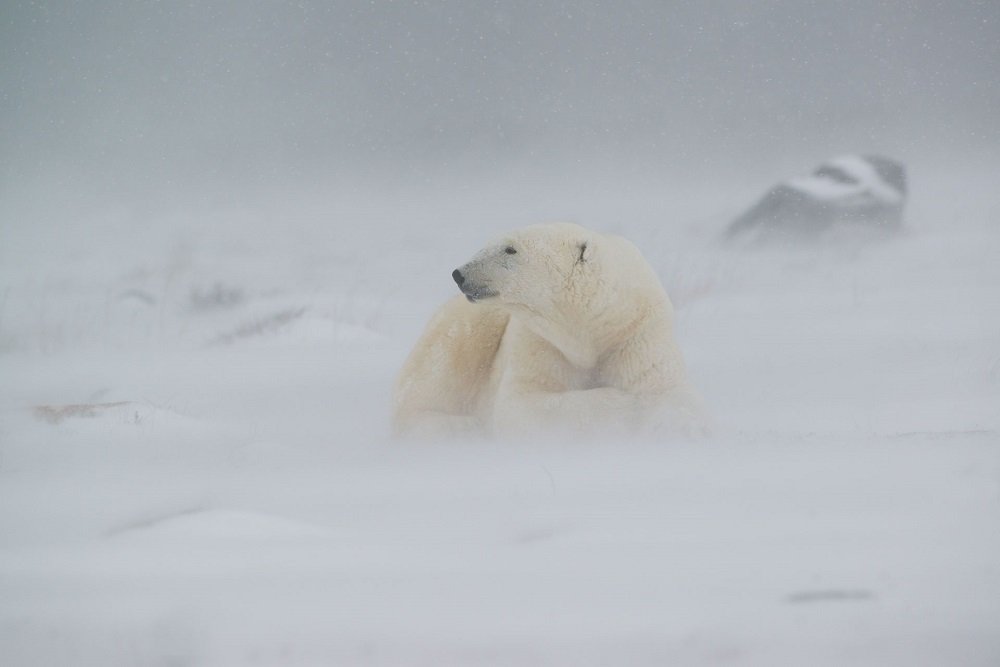
Click and Learn Photography: Hi Andrew, firstly can you tell us a bit about yourself? How long have you been a photographer and what got you you hooked on photography in the first place?
Andrew Bazeley: Actually, I got into photography when I was about 15 years old… and then photography was simply a means to an end. My consuming interest was car racing…Formula 1 and prototype sports cars to be exact…and I used photography as a tool to get me closer to the action. Of course, a 15 or 16 year old could never get photographers credentials… but sometimes I lied about my age and got them, sometimes I actually forged them and sometimes I managed to climb the fence and get into the areas with the pro photographers. I had some adventures, I had some close calls, I learned photography… and most importantly, I got really close to the racing action. 10 years later, I was a professional racer, competing at a world class level in the same races that I had previously sneaked into. Photography, though not forgotten, was put on the back burner.
Fast forward a couple of decades, a marriage and a couple of children. Car racing was long over and I was running a profitable business in the oceanographic industry. My wildlife photography interest was sparked when I read an article predicting the imminent demise of the polar bear due to climate change. I bought a Nikon D200, a couple of lenses, a ton of cold weather gear and headed off to Churchill, Manitoba, to photograph the last few polar bears on the planet.
Well, I didn’t do too well photographically, polar bears didn’t go extinct, global warming is very real… and I suddenly had a new passion. I have returned to Churchill now about 15 times to shoot polar bears and hang out with my friends there. I have now published a book on polar bears, “Waiting for Dancer”, with my photos and some pretty riveting writing by my guide, Dennis Compayre, who actually grew up around the bears. I have also appeared onscreen in a television series, “Polar Bear Town”, which was broadcast in the US on the Smithsonian Channel.
But my wildlife photography is not limited to just polar bears. I have traveled to Africa 4 times, Alaska 2 times, the Amazon several times and to many places in the US… all to photograph animals.
You Might Like… Behind the Lens with Alex Pflaum
Click and Learn: Well, I have to say that’s one of the more unusual pathways into photography that I’ve heard!
I feel like wildlife photography is almost unique in how connected it can make the viewer feel. Because of the animals in the images it’s almost inevitable that each photograph comes with it’s own backstory that enhances the experience. Could you share a bit of the story behind this image?
Andrew: I have had good success as a wildlife photographer because I am able to go into the animals environment without fear, without excitement, and without threatening them. The animals sense this and let me into their world. Sometimes they are interested and curious, but most often they just go about their lives as normal. This…and lots of patience….are the keys to successful wildlife photography.
The photograph of the polar bear in the storm did not quite follow this pattern. Dennis and I were in my old Suburban, Big Red, and had been watching a large male as the storm developed. We knew that there were two other bears lurking nearby but lost sight of them as the storm increased and visibility dropped. I was not able to get the camera angle that I wanted from the window or the roof hatch of the Suburban, so Dennis and I got out so I could shoot from the ground. At first, I slid underneath the Suburban, to shield me from the growing storm and also protect me from the two other bears that were somewhere behind us. However, I was so low to the ground that the blowing snow totally obscured the bear…I couldn’t see anything in the camera viewfinder. So, I crawled out and ended up taking the shot from a crouching position, with the bear totally vanishing as the wind gusted and coming into view again as it died down. And while I was shooting, one of the other two bears rushed us from behind, and only turned and retreated when Dennis chambered a round in his shotgun. So it ended up being a pretty exciting photo shoot.
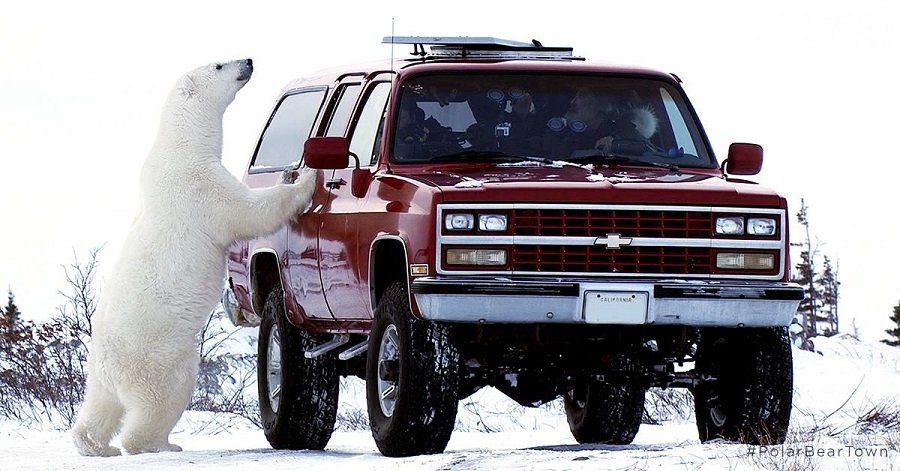
Click and Learn: That’s more than just a pretty exciting photoshoot in my eyes!
I notice looking through your portfolio that, whether it’s in the snowy reaches of Canada, the plains of the Serengeti, or even underwater, you do tend to focus on the apex predators of the environment. Is this adrenaline and sense of possible danger something you think drives or helps your photography, or do you just prefer getting up close and personal with some of the most dangerous animals on the planet?
Andrew: I don’t really get any adrenaline rush from doing what I do, which is probably unusual. But remember, I don’t experience any excitement or fear and those are things that stimulate adrenaline. If you are pumped full of adrenaline and all of the emotions that are associated with it, the animals will sense it and either leave or attack.
As far as apex predators are concerned, you are absolutely correct…I really do enjoy hanging out with them. And it is not for the adrenaline rush of cheating death or whatever – it is to be close to these incredibly powerful and sometimes dangerous animals and for the satisfaction of being allowed into their world. It just feels good… great in fact. Who wouldn’t want to sit in the corner of a room during a meeting of world leaders….to me, these apex animals are world leaders.
I have been in the water with great white sharks, killer whales and a polar bear….and I have been on the ground with polar bears, grizzly bears, lions, elephants and hippos. Let me tell you about a few of those adventures:
Several years ago, I was photographing great white sharks at Guadalupe Island in Mexico. The shark cages are typically mounted to the stern of a ship and the top of the cage is about one foot below the water surface. This is great for viewing and photographing sharks underwater, but those shots tend to all look pretty much the same. I really wanted to get an over/under shot of a great white, one that would show the shark in its underwater world while also showing the other world above. I convinced the boat captain to let me shoot from on top of the cage. Actually, my camera and upper body were on two boogie boards stacked together and just my legs were still on the top of the cage. With this setup, I was able to get close enough to the sharks, maybe about 18 inches, to get the shots I was looking for. I think it turned out pretty well… what do you think?
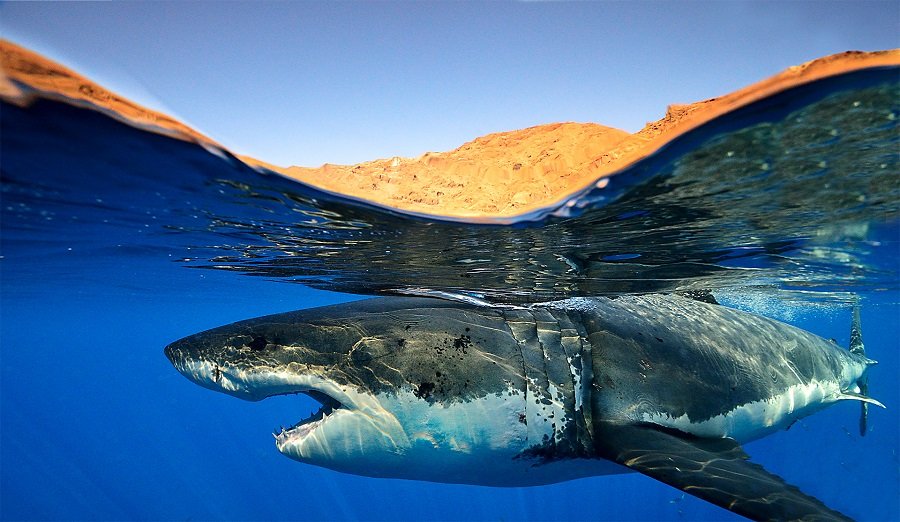
One polar bear photo I was missing was a truly good swimming shot. Buoyed by my success shooting the over/unders of the great whites, I decided to try the same with polar bears. I had to wear a wetsuit, since the subarctic water is near freezing, and we rigged up a harness which was attached to a small Zodiac boat with about 100 feet of rope. The plan was that Dennis would tow me, using the boat, so that I would be right beside a swimming bear for the ultimate over/under shot. Well, things don’t always go to plan! We did find a swimming bear, I did get into the water and Dennis did tow me alongside the bear. The problem was that Dennis was not comfortable towing me closer than about six feet from the bear, and I needed to be about three feet from the bear….at the other end of a 100ft rope, he just couldn’t judge the separation distance very well. It made for great TV and I got plenty of shots, but none were good enough to publish.
Click and Learn: That makes sense, although I don’t think I could ever stem that adrenaline rush and nervous excitement in those situations, so that’s a real skill you have there.
The over/under shots of the Great Whites are phenomenal, and I love that you were able to think outside the box to make the shot you had in your head come to fruition. It’s a shame that it didn’t work for the polar bear, but it definitely makes for a great story and some epic TV viewing.
Would you mind telling us a little more about Waiting for Dancer and the subsequent TV series? What was the inspiration behind the book and how did you and Dennis set about planning such a lengthy process?
Andrew: 12 years ago, I read an article on global warming. Among other things the article stated that polar bears were going extinct… and quickly. Deciding that I should see them first, I booked a trip to Churchill, Manitoba. A week on the tundra in a tundra buggy hotel, which is six tundra buggies all strung together with sleeping cars and a dining car and a lounge car. It sounds incredible…but it wasn’t . So, at the end of the week when we came off the tundra, I headed to a nearby bar in search of a local who could help me get closer to the bears. And that is how I met Dennis, a local who had grown up among polar bears and who was affectionately referred to around Churchill as “Dennis the bear man”.
Well Dennis and I hit if off right from the start, and the following year on our first trip out on the tundra we had a great time and I got some great shots. So great in fact, that I started thinking that maybe if I were to come back for a couple more years I would get enough good stuff to publish a book about bears. In discussing this with Dennis, I learned that he had a lot of short stories that he had written over the years about his life growing up in Churchill with the ever present specter of the bear limiting outside activities and invading his dreams. And about his later life as the first tundra buggy driver actually meeting a yearling bear cub, naming him Dancer, and continuing a friendship with Dancer for the next 15 years.
For me, hearing this was too good to be true. Not only did we have some really good polar bear photographs to put into a book, but we had some truly epic stories to round it out. And so began what came to be an eight year odyssey. Each year at bear season, Dennis and me going out onto the tundra searching for the perfect shot. And the culmination of all this effort was our publishing our book, “Waiting for Dancer”.
Four years ago, the US broadcaster, Smithsonian Channel, started production on a natural history / reality TV show called “Polar Bear Town”. The show combined the antics of several locals, including Dennis, with some truly spectacular natural history footage of polar bears. Since Dennis and I were always working together during bear season, I was an on-screen character in the show as well, despite being just about the last thing from a local. “Polar Bear Town” was broadcast for two seasons, and we had some truly memorable experiences, some on camera and some not. It was a well reviewed show, nominated for an Emmy, that will likely lead to other shows in the future.
-
Waiting for Dancer - An ode to the Canadian wild.
- Dennis Compayre (Author)
- English (Publication Language)
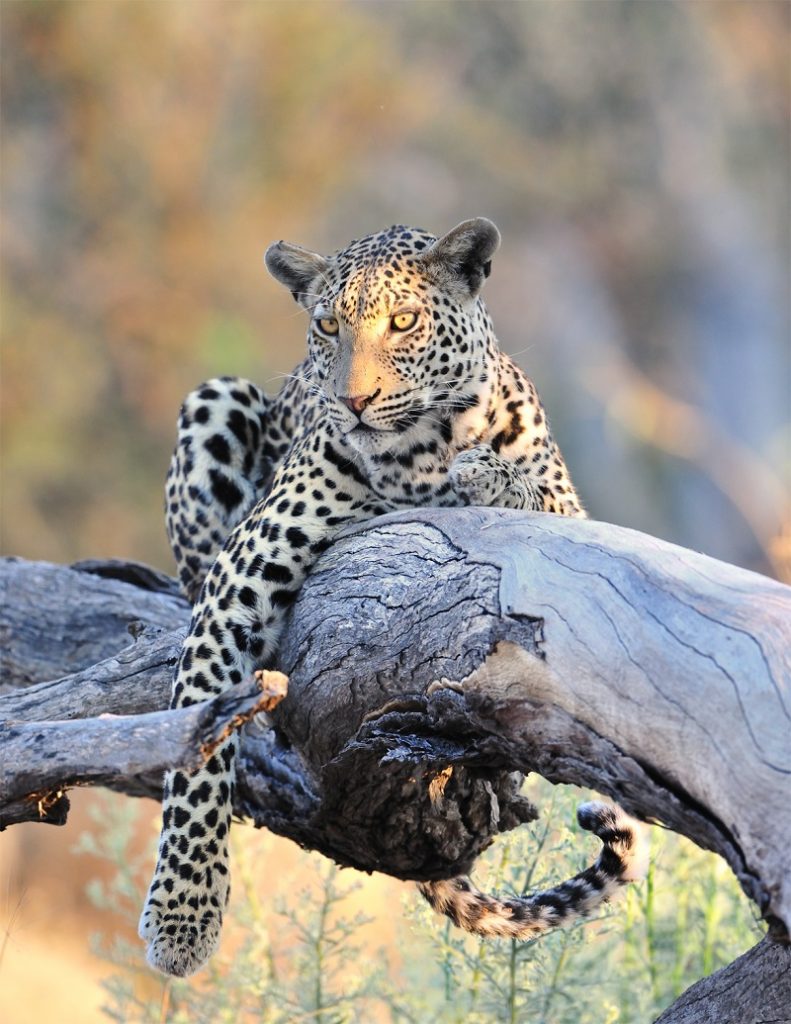
Click and Learn: That’s a great story, wildlife and nature really has a way of bringing people together. Is there somewhere that our readers can watch Polar Bear Town online in case they missed it the first time around?
What photography related plans do you have for the future? Are there likely to be more books in the pipeline or was Waiting for Dancer just a one off that came about because of a chance meeting in a local bar?
Andrew: You are absolutely correct…..there is nothing more magical than being in the natural world and being with wild native animals. It is an incredible shame that we have destroyed and desecrated so much of it around the world… and there seems to be no end in sight.
Episodes of Polar Bear Town can be viewed on the Smithsonian Channel website.
I will most certainly return to Churchill to photograph polar bears in November 2019. And we are in discussion with a TV production company about a new movie in which Dennis and I will track a mother polar bear and her cubs as they make their way from the birthing den and out onto the sea ice….a trek of about 50 kilometers. This is something that has never been done, and certainly not documented.
I am also tentatively planning a trip to Tanzania, which is truly the birthplace of mankind and so many animal species. I have not been to Tanzania for about five years, and my guide there has written me several times saying that I must return before it is all gone….an absolutely chilling thought and one which brings me almost to tears.
I am also in the planning stages of a trip late in 2019 or early 2020 to Tromso, Norway, to swim with and photograph orca. To me, orca are THE apex predator on the planet.
And I am in talks with some friends to go to Tonga to swim with humpback whales….humpies.
Click and Learn: That movie sounds like a fascinating watch, hopefully you and Dennis can bring the idea to reality!
It sounds like you’ve got a lot of adventures in the pipeline, although as you say you’ll have to act fast before humanity does any more damage to the incredible world we live in. One thing I love about wildlife photography, though, is the way it can truly change perceptions. Wildlife photographers and videographers truly can change the world by bringing these tragic stories to the public eye, so you can take some solace in the fact that the work you’re doing is making a difference in some way!
It’s been a pleasure talking with you Andrew, and I look forward to seeing what the future brings for your photography.
Read More…
How to Use Leading Lines to Improve Your Photography Composition
The Best Landscape Photography Lenses
Tearing Up the Rulebook – 12 Photography Rules and When to Break Them
29 Perfect Gifts for Photographers
 |
 |
 |
 |

About Alex W.
Alex is the owner and lead writer for Click and Learn Photography. An avid landscape, equine, and pet photographer living and working in the beautiful Lake District, UK, Alex has had his work featured in a number of high profile publications, including the Take a View Landscape Photographer of the Year, Outdoor Photographer of the Year, and Amateur Photographer Magazine.
Thoughts on "Behind the Lens – Andrew Bazeley"
 |
 |
 |
 |
You can Get FREE Gifts. Furthermore, Free Items here. Disable Ad Blocker to receive them all.
Once done, hit anything below
 |
 |
 |
 |
